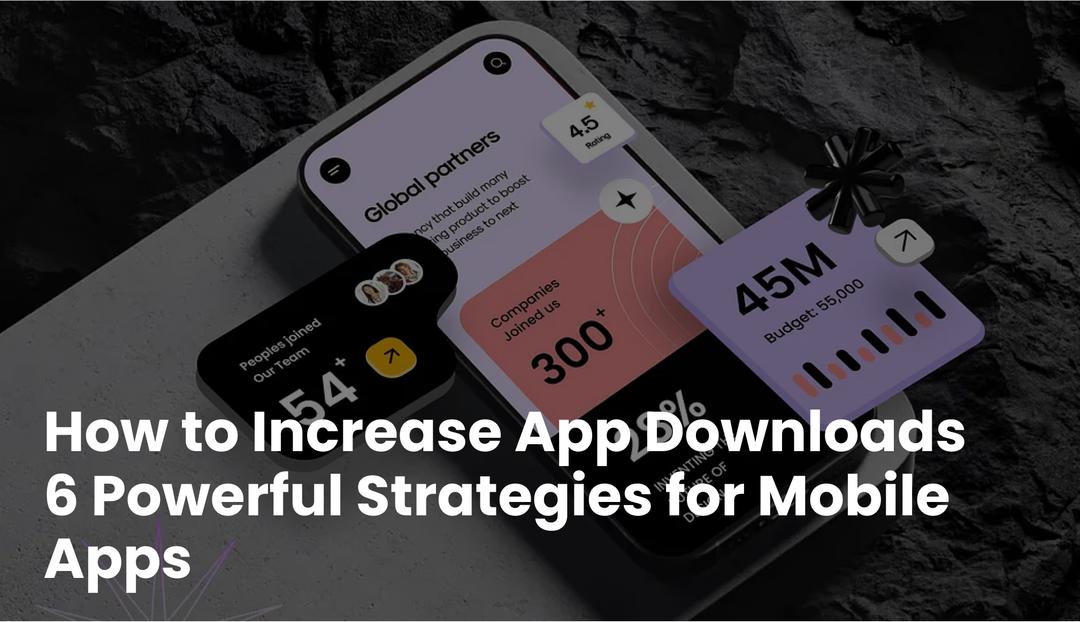By 2029, the global fintech market is anticipated to grow to $608.35 billion. Even more astonishing is the fact that by 2024, 90% of consumers will make mobile payments using smartphones. These figures make it quite simple that digital financial solutions are now essential rather than merely a fad.
Nevertheless, creating a successful fintech application whether it be a mobile banking app, digital wallet, or investment tracker is not at all easy. With development costs ranging from $30,000 to $300,000 and timelines as long as 18 months, this is a high-stakes endeavor.
The good news? With over 26,000 fintech startups around the world, there’s a shown blueprint for what works and what doesn’t. We’ll walk you through the crucial processes of creating a creative, legal, and scalable fintech app in the guide below. Let’s begin.
What is Fintech in Simple Terms?
The use of modern technology to improve and simplify financial services is known as financial technology, or fintech for short. In a nutshell, it refers to the use of software, apps, or digital technology to make lending, investing, banking, and payments safer and easier.
Fintech, which includes mobile wallets and online lending tools, makes financial problems easier for both consumers and businesses. Among the technologies that help automate procedures and enhance the speed, security, and intelligence of financial services are blockchain, machine learning, and artificial intelligence (AI).
As more entrepreneurs and enterprises enter the digital financial market, there is a growing need for better, more innovative fintech solutions. This is driving the creation of innovative and exciting new tools and concepts for money management in the future.
How Fintech Is Shaping the Future of Payments
Fintech is transforming how we bank, pay, and handle our finances. The transition to quicker, more intelligent payments is well under way, with the worldwide fintech market expected to reach $608 billion by 2029.
By 2024, almost 90% of smartphone users are expected to use mobile payments. Contactless checkouts and cryptocurrency wallets are just two examples of how fintech is making transactions safer, faster, and simpler than ever before.
With just a tap, users can pay, invest, or manage accounts no bank branch needed.
AI-powered personalization, digital wallets, and open banking are shaping a seamless financial experience. Meanwhile, fintech is breaking barriers to inclusion by reaching users previously left behind by traditional banks.
At BitsWits, we help businesses launch future-ready fintech apps that are secure, scalable, and built for real impact. If you’re ready to lead in the next wave of digital finance, we’re here to make it happen.
Types of Fintech Applications (With Real-World Examples)
The fintech industry is growing and it’s far from oversaturated. As more consumers and businesses demand smarter, faster, and more convenient financial tools, there’s huge opportunity to build innovative fintech applications across different sectors.

From mobile banking to investment and lending, let’s explore the most common types of fintech apps that are reshaping how people manage money in 2024 and beyond.
1. Digital Banking Apps
Digital banking apps make managing finances easier by putting everything a traditional bank does right into your smartphone. Without ever going to a bank, customers can open accounts, check balances, transfer money, pay bills, and even apply for loans.
With better security, real-time alerts, and 24/7 account access, these mobile banking choices provide seamless user experiences.
For instance: N26, a European bank that prioritizes mobile, enables customers to open totally digital bank accounts and handle their finances with a few clicks. It uses biometric login, 3D Secure technology for safe online payments, and restricts account access to one verified smartphone—enhancing both security and trust.
2. Digital Payment Apps
Digital payment apps are among the most popular types of fintech solutions. By facilitating quick, safe, and contactless payments via mobile devices, they do away with the need for actual cash.
Without a real card, these apps let users send and receive money, pay bills, and purchase online. As the globe transitions to cashless commerce, digital wallets and online payment systems have become essential.
For instance: PayPal, is a popular online payment system that allows secure transactions without asking users to reveal their financial details. It takes bank transfers, credit cards, and debit cards and features an easy-to-use interface. PayPal is used by both consumers and businesses to effectively transmit money across borders.
3. Investment Apps
Fintech applications facilitate portfolio management, investing, and stock market monitoring. These platforms remove traditional barriers to entry, such as high fees or complicated account setups, so that anyone may start investing with just a few dollars.
They usually provide trading tools, real-time market data, and educational resources to assist customers in the investment process.
For Instance: With its commission-free platform, Robinhood has increased accessibility to stock and cryptocurrency trading. Beginner investors love it because of its simple design and connection with thousands of banks.
An excellent resource for financial education is Invstr, which gamifies investing and blends community learning with actual trading.
4. Digital Lending Platforms
The method of borrowing is being revolutionized by digital lending applications. Users may apply for loans, track applications, get funding, and manage repayments more quickly and easily with these platforms.
Digital lending platforms offer a hassle-free, paperless experience for both traditional financial institution loans and peer-to-peer (P2P) loans.
For instance: Dave is a digital lending service that provides short-term, small loans for overdraft protection or emergencies. It is a dependable financial companion for people living paycheck to paycheck because it assists with budgeting, sends low-balance notifications, and has a low monthly cost.
5. Digital Insurance (InsurTech) Apps
Digital insurance apps, or InsurTech, simplify the process of acquiring, managing, and submitting claims for insurance coverage. These programs speed up claims, cut down on errors, and stop fraud by using automation and artificial intelligence.
By streamlining paperwork and offering quick policy comparisons, InsurTech platforms enable customers to more easily get the coverage they need,when they need it.
The clever car insurance comparison app, for example Artificial intelligence (AI) is used by Insurify to help customers find the best rates and coverage. By providing consumers with instant quotations and allowing them to purchase insurance without speaking with an agent, it streamlines and expedites the process.
6. Regulatory Technology (RegTech) Apps
RegTech apps are designed to help fintech companies and financial institutions comply with evolving regulations. These programs simplify complicated processes like KYC (Know Your Customer), AML (Anti-Money Laundering), and other risk management strategies.
Because worldwide compliance standards are always changing, RegTech systems are crucial for reducing manual labor and avoiding regulatory fines.
For example, PassFort, a RegTech platform, streamlines compliance procedures. Businesses may design custom rules, verify identities, monitor risks, and generate audit-ready reports all through a single interface.
A Simple, Human-Centered Guide to Building a Fintech App That Succeeds
Are you considering developing a financial app but unsure where to begin? The good news is that you’re not alone and it’s quite doable. If you have the right approach, resources, and people on your side, you can create an app that not only functions but also actually engages consumers and makes a difference in a crowded market.

This thorough guide will teach you how to develop a fintech product that consumers adore and trust, whether you’re making an intelligent investing software, a mobile banking solution, or a digital wallet.
Step 1: Define What Your App Will Do—and Who It’s For
Every successful fintech app starts with a clear idea. What financial problem are you solving? Is your app helping people manage their money, send payments across borders, invest wisely, or apply for loans easily?
Now think about your audience. Are you targeting busy freelancers? College students managing their first budget? Small business owners needing better tools? Everything else, including features, branding, and marketing, is made easier when you know your “who” and “why.”
It’s a good idea to start locally before expanding internationally, particularly if you’re new to the industry.
It gives you a focused launch base while leaving room to grow.
Step 2: Make Sure You’re Legally Covered
Since fintech apps handle sensitive financial data, proper compliance is a must. The following rules may apply to your app, depending on where your users reside and the services you provide:
- KYC (Know Your Customer)
- AML (Anti-Money Laundering)
- PCI DSS (Payment card security standards)
- GDPR or CCPA (Data privacy laws)
It’s important to bake compliance into your development plan right from the start. It not only keeps you safe legally it also shows users they can trust your app with their money.
Step 3: Know the Market and Carve Out Your Niche
With thousands of fintech apps already out there, how will yours stand apart?
Start by doing a little detective work. Check out what people are saying in app store reviews. See what users love and what frustrates them. You might find a gap: maybe existing apps are clunky, slow, or missing useful features.
This step helps you sharpen your app’s unique value. It’s what makes people choose your app over the rest.
Step 4: Focus on What Really Matters First
Too much, too soon is a common mistake made by financial businesses. Particularly at the beginning, keep things basic.
Consider: What features are essential for my users from the start? Maybe it’s secure login, easy money transfers, or real-time spending alerts. Whatever it is, do it well and keep it fast, safe, and easy to use. Users don’t need dozens of features, they want a few that work flawlessly.
Step 5: Find the Right Development Team
You don’t have to face this alone. It requires IT, security, and financial experts to build a fintech app. Make sure your staff has actual experience in this field, whether you want to work with a fintech development business like BitsWits or recruit in-house.
Having knowledgeable professionals on your side can save you time, frustration, and expensive errors in areas like compliance, UI/UX, and backend security.
Step 6: Choose the Right Technology
The tech stack of your app will affect its future scalability, security, and performance.
Swift (for iOS) and Kotlin (for Android) are good options for mobile applications.
Want to launch on both platforms faster? Go cross-platform with React Native or Flutter.
Fintech programs require scalability and dependability, which backend frameworks like Node.js, Python (with Django), or Java (Spring Boot) provide.
Additionally, ensure that your app has safe logins, robust encryption, and easy updateability as your company expands.
Step 7: Plan Your Budget Early
Developing a financial app can cost anywhere from $30,000 to $300,000, depending on features, design, security, and integrations.
A typical error is to underestimate the budget. Don’t forget to factor in:
- Development and design
- Security and compliance
- Testing and quality assurance
- Ongoing maintenance and updates
Having a clear budget keeps your project on track and prevents delays down the road.
Step 8: Start with a Minimum Viable Product (MVP)
Before building the full app, launch an MVP a simple version with just the core features.
This lets you test your idea, gather user feedback, and fix issues early. It also shows potential investors and users that you’re serious, and that your idea works in the real world.
Think of your MVP as your app’s first draft. It’s where you learn what works—and what needs to improve.
Step 9: Launch It, Learn from It, and Keep Improving
Once the software is available on the market, your work is far from over. When the software is out, your effort merely begins; it doesn’t finish.
- Observe how users interact with your program.
- Observe how users engage with your application. (What do they adore? What is unclear?) Utilize those comments to hone and enhance.
The sector of fintech is changing quickly. Be open to new features like blockchain integrations, open financial APIs, and forecasts powered by AI. If you keep improving your app, it will grow with your users.
Also Read: A No-BS Guide on Fintech App Development Costs and Everything You Need to Know
Choosing the Right Tech Stack for Your Fintech App
Your financial software’s performance, scalability, and security are greatly impacted by the technology stack you choose. Everything is impacted, including user experience, app speed, and long-term maintenance and development costs.

Choosing the appropriate tools from the start is so essential to your success.
Frontend Technologies for Fintech Apps
Since the frontend is where people interact, it must be seamless, quick, and easy to use. Leading financial platforms use the following three widely used frameworks:
- React: This is the preferred option for finance applications that require quick updates and interactive dashboards. Using reusable components to create dynamic user interfaces is made simpler with React. Apps like Robinhood provide smooth trading experiences by utilizing React.
- Angular: If you’re looking for a more complex or enterprise-level solution, this financial platform is an excellent option. Because of its well-known structure and integrated functionality, Angular is perfect for apps that require sophisticated backend features, such secure payment portals that resemble PayPal.
- Vue.js: Vue is easy to use, adaptable, and quick to set up, making it perfect for lightweight financial tools. It’s especially useful for building personal finance apps or budgeting tools that don’t require enterprise-level infrastructure.
Backend Technologies That Power Fintech
The backend is what powers everything behind the scenes, even if users only see the frontend. It handles data securely, executes transactions, and makes sure the app runs smoothly even when there is a lot of traffic.
- Node.js: Well-known for effectively managing real-time transactions, Node.js is ideal for applications that need quick replies, such as stock trading platforms and payment processing platforms. Multiple user activities can be handled smoothly at once because to its non-blocking architecture.
- Python (Django or Flask): Because of its robust frameworks and simple syntax, Python is frequently used in fintech. Particularly, Django has integrated security protections and is ideal for applications that handle private user information, like mobile banking apps or loan platforms.
- Java (Spring Boot): Java is a reliable option for extensive finance projects that must handle massive volumes of data while maintaining a high level of security. Because of its multithreading capabilities, it is perfect for applications that manage multiple transactions at once, much like traditional banking systems.
Why Now Is the Perfect Time to Launch Your Fintech App

There has never been a better moment to embrace the fintech revolution that is changing the face of global financial management. Whether you’re considering starting a fintech company or creating a mobile banking app, this is an excellent moment to create something creative, practical, and lucrative.
Quick Development and Acceptance
Fintech is already commonplace rather than just a fad. These days, practically every smartphone user has at least one fintech app, whether it’s for digital banking, online payments, or peer-to-peer transactions. Businesses across a range of sectors, including traditional banks and retail giants, are utilizing fintech solutions to improve customer happiness and automate procedures.
According to recent studies, 96% of global users are aware of at least one fintech payment or transfer service, and over 75% actively use fintech tools to manage finances, make investments, or track expenses. This growing user base shows strong demand and confidence in fintech platforms.
Endless Possibilities in Fintech Development
From AI-powered investment platforms and budgeting apps to digital wallets, payment gateways, and mobile-only banks, fintech offers a broad landscape of opportunities. Whether you aim to simplify financial planning or build a fast, secure payment solution, there’s room to innovate.
Now is your chance to build a solution that addresses evolving needs especially as users seek speed, simplicity, and smart money management tools at their fingertips.
A Booming Customer Base
Today’s tech-savvy, mobile-first consumers are ready for self-service solutions that provide them financial autonomy. People are moving away from traditional financial institutions as a result of contactless payments, smart investing, and 24/7 digital banking.
The fintech industry is expanding quickly due to the growing need for branchless banking and mobile financial services, and your app may become the next preferred platform for consumers seeking control and convenience.
Access to Advanced Technologies
Fintech’s underlying technology is developing quickly. Artificial intelligence (AI), machine learning, blockchain, the Internet of Things, and big data have made it easier than ever to create scalable, secure, and personalized banking apps. Whether you’re creating an app for real-time fraud detection or a robo-advisory tool, the technology stack is ready and waiting.
Fintech Beyond Finance
Fintech is no longer just used by banks and insurance providers. Numerous industries, including healthcare, retail, travel, and even education, are integrating fintech services into their operations. This opens doors for businesses that don’t normally work in finance but want to improve payment systems, internal transactions, or consumer loyalty.
In a world where financial technology is permeating every industry, you are future-proofing your company by developing your fintech solution now.
Easier Access to Fintech Expertise
A robust pool of seasoned developers and experts who are knowledgeable about both technology and finance has been produced by the growth of fintech. You will have access to experts who understand how to create safe, legal, and effective apps that meet your objectives if you work with the correct fintech app development company.
Power Your Fintech Vision with BitsWits
Custom apps that are fast, secure, and ready for scale.
Get Started Today
Build Your Fintech App with BitsWits – Let’s Bring Your Idea to Life
The time to explore fintech has never been greater. This is your opportunity to develop something that will benefit both your company and your users, as there is a growing need for intelligent, safe, and easy-to-use financial apps.
At BitsWits, we specialize in fintech app development that’s fast, reliable, and built for the future. Whether you’re looking to launch a mobile banking app, a payment solution, or a custom digital wallet, we’re here to turn your vision into a powerful digital product.
As an award-winning app development company, we’ve helped startups and enterprises across industries build high-performing apps that solve real problems and deliver excellent user experiences.
FAQs












